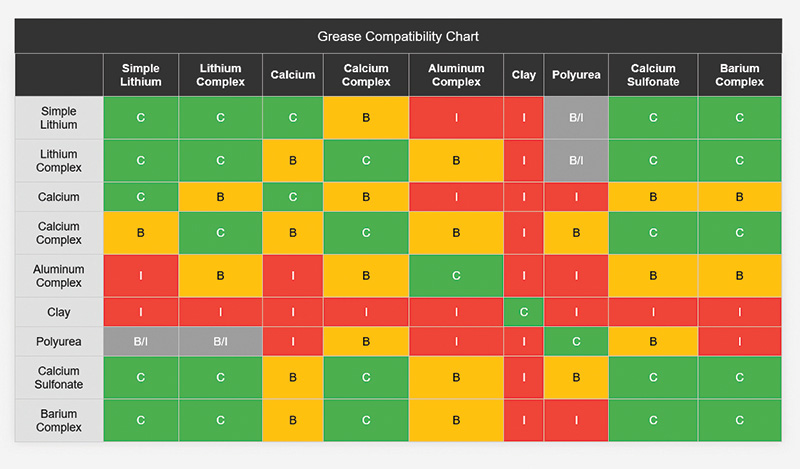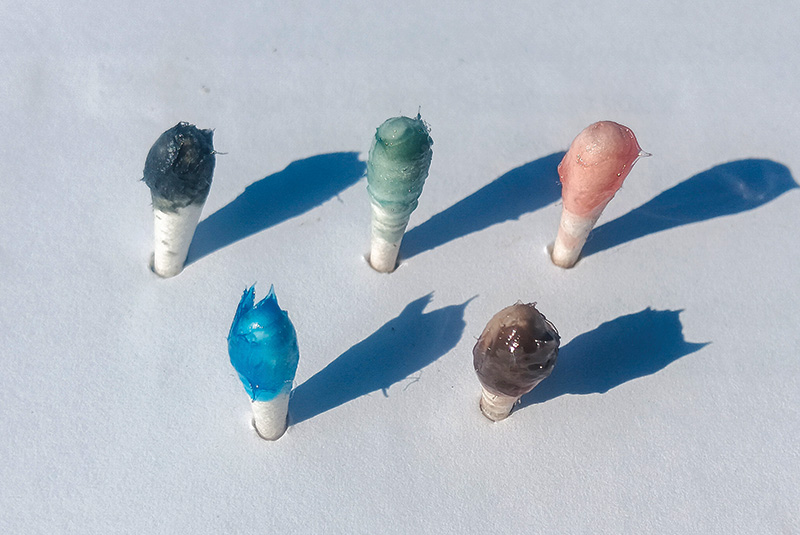
Color-coding identifies which mix of grease thickeners are compatible (C), which are known incompatibles (I) and which are borderline or incompatible (B/I) depending on real-world experience. Table was prepared by Grok AI based on dozens of studies from academics and makers of bearings, lubricants and all manner of machinery. Photos by Scott Nesbitt
While servicing the gearboxes of five straight-shaft string trimmers, I noticed the color of their grease. The Echo gearbox grease was red; the Stihl was blue; the Husqvarna was green. Two no-name heads (unreadable brand names) had brown and/or black grease.
The owner’s manuals called for No. 2 grease. Over many years, every mower deck, wheel bearing and steering link I’ve serviced wanted No. 2 grease.
Yet they all warn that mixing the wrong new grease with old grease can destroy a bearing. The danger is grease incompatibility. Let us explore what I’ve discovered, beyond the irrelevance of grease color.
In 1939, the then-6-year-old nonprofit National Lubricating Grease Institute measured the force needed to push a metal cone into a mass of grease. These tests yielded nine ratings: No. 000 (cooking oil) to No. 6 (cheddar cheese). Peanut butter compares to No. 2 grease. Food analogies are still used. Lubrication came from mineral oil in all greases. Thickness was important to match the grease to where it was going and how it got there — pour, pump or spatula.
In 1940, your grease gun’s tube said “NLGI No. 2.” It still says that today but also has the NLGI logo with letters: GC for wheel bearings, LB for chassis lube, GC-LB for both. That is from a 2019 program.
By early 2026, you should see the NLGI logo with the letters HPM (high performance multiuse) and/or HPM+ followed by code letters: WR (water resistance), CR (saltwater corrosion resistance), HL (high load capacity) or LT (low temperature). Products are still getting certification tests for this 2024 program.

Cotton swab samples of grease from trimmer heads raised the question of which grease each needed.
This coding recognizes decades of specialization. The lube could be mineral oil (natural or synthetic) or PAO (polyalphaolefin), silicon, PAG (polyalkylene glycol) or an ester.
The thickener, traditionally lithium based, could now range from aluminum to calcium to clay to polyurea (a synthetic polymer garage floor coating). Thickness still counts, so the old ratings persist.
The new code system puts for-profit grease makers and their customers on a more stable playing field. It still doesn’t say which greases are incompatible demons wanting to cause trouble.
For that, check the table to see which thickeners are incompatible. A bad “soap” mix could create a solid mass, gritty lumps or a goopy mess that dribbles away or eats the bearing. The oil component isn’t a big worry for golf course equipment. Most auto-type greases use oil similar to engine oils, which tolerate synthetic/natural blends.
For older equipment, open some wheels’ hubs and gearboxes. Does the grease look, feel and smell right? With newer equipment, check your OEM/distributor to see if there’s a list of name-brand greases they accept in addition to their OEM-branded products. This matters at warranty time.
In the great and glorious future, owner and service manuals might specify exactly which NLGI grease goes where. Maybe there will be a color code system, as with modern auto antifreeze. A guy can dream.
For now, I’ll get three tubes of major-brand OEM trimmer head grease. For the other trimmers and miscellaneous mower decks, wheels, gearboxes and steering links, I’ll spend a little extra for major brand red-and-tacky extreme pressure high temperature GC-LB HPM Lithium No. 2 grease and, like a doctor, hope to do no harm.
Scott R. Nesbitt is a freelance writer and former GCSAA staff member. He lives in Cleveland, Ga.